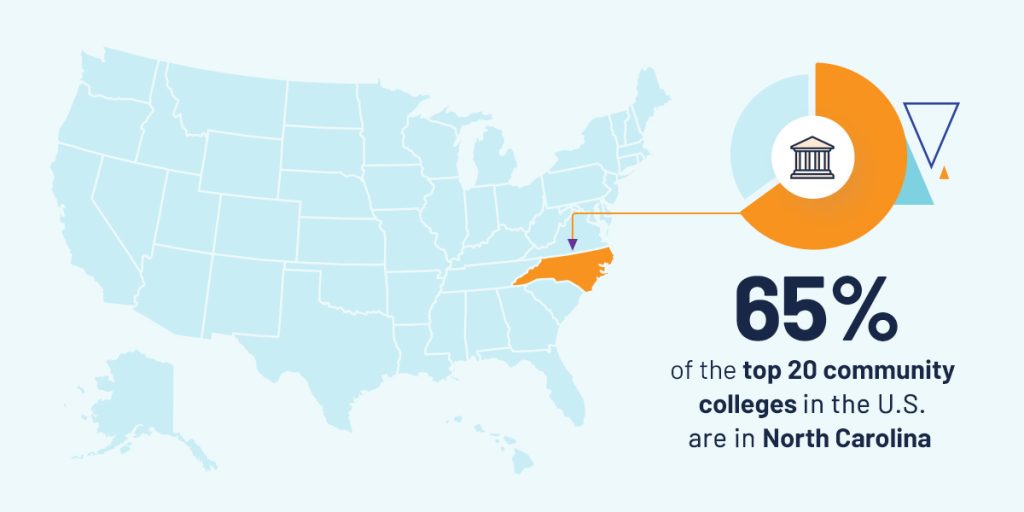




While community college students face many of the same challenges as students attending other higher education institutions, they also have their own obstacles to overcome. Four out of five, or 60 percent of community college students say they plan to transfer and get a bachelor’s degree. The reality is that only one in six of them actually does, which is less than 20 percent.
To uncover a clearer path to student success, institutions and administrators must focus on redesigning America’s community colleges on a fundamental level. Institutional support can better equip students with the skills and resources they need to thrive, allowing schools to see better outcomes, including higher retention and graduation rates.
Community college students are busy individuals. Many of them are nontraditional students — primarily older students who need to balance lots of priorities at once, from their studies to their jobs to their family commitments.
Although community colleges provide more flexible schedules and lower tuition fees than other higher education institutions, students often struggle to make ends meet. Coping with increased mental and physical health demands, as well as facing a lack of access to adequate technology, also puts them at a disadvantage.
As a result, they’re significantly less likely to earn any kind of credential than their peers who begin at four-year institutions. Because every community college is unique, making an effort to listen to and understand the student population will help administrators and faculty design programs and services that better meet student needs.
The characteristics of successful community college students are diverse and versatile. Their skills and experiences can shape them into excellent students who make the most of their education and careers. Some characteristics that can inspire student success at community college include:
The diversity present at many community colleges means student success, and the characteristics associated with it can take on many different forms. Each student has their own unique strengths that set them up for success, and your institution can help by providing the proper support services.
When schools want to boost student success, implementing the right strategies and tactics can support your population and help students achieve their academic and educational goals.
Here are some ways excellent community colleges set their students up to succeed:
Some of the nation’s best community colleges are located in North Carolina, according to a 2024 SmartAsset study. In fact, the state’s community college system is so strong that it makes up 65 percent of the top 20 community colleges in the country.

The ranking is based on various factors, including:
While the first two metrics are relatively easy to control, it’s more complex to pin down the reasons behind overall student success. So what are North Carolina community colleges doing right? And how can other community colleges tap into similar success?
Besides their location, there’s another common thread among many of the top-performing community colleges — they use Watermark Student Success & Engagement, a student success solution. Watermark has been a proud partner of the North Carolina Community College System (NCCCS) for over a decade and has worked with many of the top colleges in the country.
The platform uses predictive analytics to identify at-risk students early on and connect them to the necessary resources or interventions, thereby improving student engagement. Watermark has delivered proven results nationwide in engagement, retention, persistence, and completion rates, measuring its technology’s efficacy by the number of students crossing the finish line to graduation or transferring to a four-year institution.
We spoke to some of the top-performing community colleges about how Watermark solutions are helping them stand out among the nation’s more than 1,000 community colleges. Let’s look at these institutions in greater detail to hear their firsthand experience with Watermark.
SmartAsset named Brunswick Community College the nation’s number-one community college for two consecutive years. The school’s outstanding graduation and transfer rates are part of what propelled it to the top of the list. So what’s the key to their success?
The school’s president, Gene Smith, said that partnering with Watermark has bolstered the school’s focus on student success. President Smith said, “Since implementing Watermark, we are so much better equipped to identify students in need and connect them to campus support services.”
He continued, “We’ve opened up communication lines with students about their course successes and struggles, and as a result, we’ve increased our understanding of persistence and retention patterns amongst our student populations.”
Vice President of Student Affairs Denise Houchen-Clagett, Ed.D., added that Watermark’s platform helped faculty and staff provide seamless support services during each student’s transition to remote schooling. She highlighted that the platform’s texting capabilities were especially helpful as they enabled Brunswick staff to communicate with students to assess their technology needs.
Houchen-Clagett said, “With Watermark, success coaches are able to continue working their caseloads, communicating with students, and providing outreach services to those in need.”
Pamlico Community College in Grantsboro, North Carolina, boasts a consistently high student retention rate and is one of the most affordable community colleges in the state. By leveraging Watermark’s notices about student performance, Cristy Lewis Warner, Counselor and Director of the Career Center at Pamlico, stays ahead of student needs. She explained, “Watermark keeps instructors, advisors, and counselors updated on students in real time with any concerns regarding the student, as well as how they are doing academically.”
The institution participated in the First in the World (FITW) research program with impressive results. FITW, a five-year study, was designed to determine if proactive and individualized success coaching at 10 North Carolina community colleges would improve student success. At Pamlico Community College, course completion rates for students attempting spring and fall coursework increased by 16.3 percent since working with Watermark.
Carteret Community College is one of the state’s highest-ranking community colleges and is ranked in the top 10 in the country.
Allison Daniel, former Director of Counseling, Disabilities, and Retention at Carteret, said she appreciated Watermark’s holistic approach to student information. “Watermark gives us the ability to quickly and easily access the right information and get it in the right hands to make decisions, ensuring we support the right student at the right time.”
During her time at Carteret, Daniel used the Watermark platform to encourage success among struggling students. She appreciated the ability to tailor the software to each student’s and school’s needs and added that through Watermark, success coaches and counselors could “track the students and the communication from all campus stakeholders in seconds.”
Carteret participated in a five-year study with First in the World as well as the Minority Male Success Initiative (MMSI). The MMSI, which concluded in 2023, was a three-year research study with Watermark that aimed to improve minority male student outcomes by promoting participation and collaboration between the student and the institution.
Montgomery Community College in Troy, North Carolina, takes great pride in its graduation and transfer rate.
“Witnessing a student be successful is one of the most rewarding aspects of working in education,” said Diana Sanchez, leader of Counseling & Disability Services at Montgomery. “The Watermark early alert system is a tremendous asset in helping us increase student success.”
Montgomery Community College used the Watermark student success platform to increase retention and completion rates among minority male students as part of the MMSI.
With a graduation and transfer rate of 92 percent, Sampson Community College earns its spot as one of the top U.S. community colleges. “When asking other institutions how they addressed retention and completion, Watermark was always one of the top three answers,” said Dr. Marvin Rondon, Dean of Student Services and Institutional Effectiveness at Sampson.
Dr. Rondon found Watermark’s data-driven approach and predictive analytics to be especially insightful when presenting opportunities to expand the college’s enrollment and retention strategies. Automated alerts and easy-click referrals allowed his team to proactively reach out to students and provide more personalized support. He noted, “With the help of Watermark, we are able to serve all students in a way that we’ve never been able to before.”
Sampson Community College was also a participant in the MMSI.
According to recent community college student success statistics, Randolph Community College is yet another high-ranking North Carolina institution. Former Randolph Success Coach Pam Wiggins credited Watermark with keeping students in school, saying that the platform is one of the most critical tools in her success coaching toolbox.
Wiggins used Watermark’s data-specific tools daily to uncover the risk factors that affect individual students and develop interventions that enable success. With comprehensive outreach tools and trend-setting patterns, she identified which students required interventions.
Suzanne Rohrbaugh, Vice President for Instructional Services, added that the Watermark platform “improves internal communication among various areas of the college to be better informed about students and their progress.”
The persistence rate for high-risk students increased by 12 percent since working with Watermark.
These top-ranking colleges all take unique approaches to student success, but some common threads are clear. All of them leverage high-quality, real-time student data to inform decision-making. They also take a hands-on approach, supporting students at every step on the way to completion. Some of the strategies these community colleges share include:
In summary, all of these top performers focus on quantifiable insights that help them allocate resources in the right places. Their strategies are the opposite of hit-and-miss. Instead, each strategy is proactive, data-driven, and collaborative. With Watermark on their side, they’re driving meaningful change for students and the entire institution reaps the benefits.
Completing higher education is challenging for any student, but at-risk groups face unique hurdles that could cause them to drop out altogether. Many of these students lack an understanding of the resources they need and try to push through unassisted. The institution may encounter its own challenges in identifying the students who need their support before it’s too late. Watermark Student Success & Engagement can help you navigate the challenges and identify opportunities to boost community college student success.
With Watermark, institutions like yours can follow the examples set by these North Carolina community colleges. Implementing Student Success & Engagement at your institution can open at-risk students up to avenues they previously may not have considered, which can significantly improve their chances of getting back on track. This solution is part of our complete Educational Impact Suite (EIS) — a centralized system that collects, analyzes, and synthesizes data across your institution.
Give everyone at your community college the tools to succeed in driving student success. Contact us today to find out how a partnership with Watermark can help.






























































































































































































































































































































































































